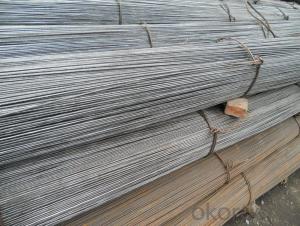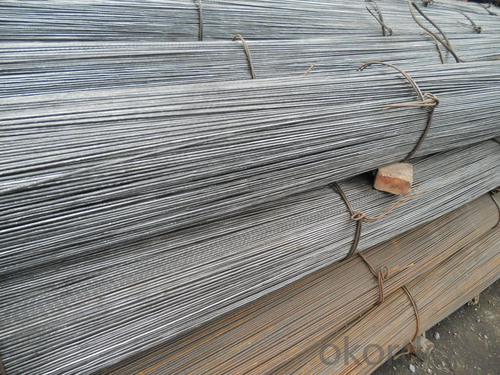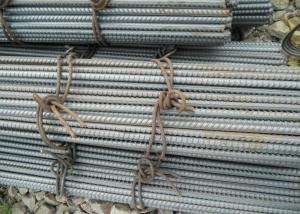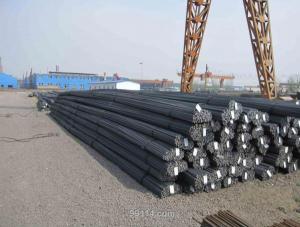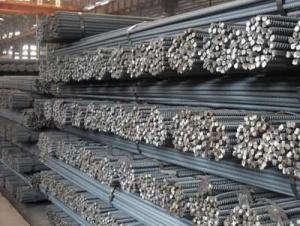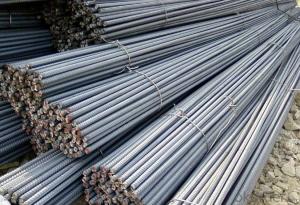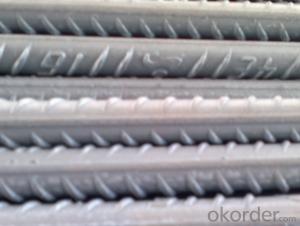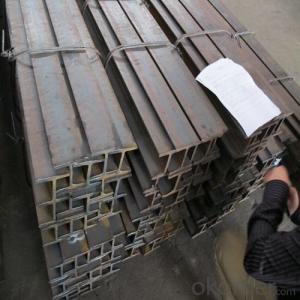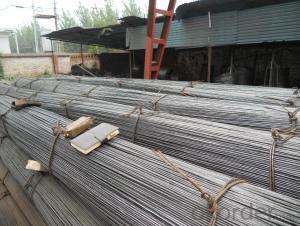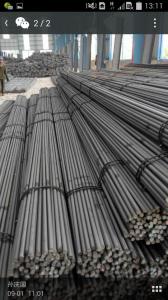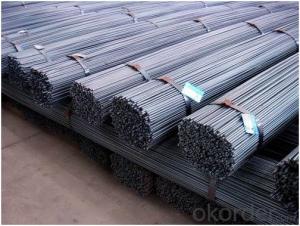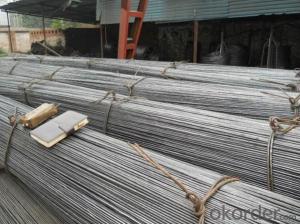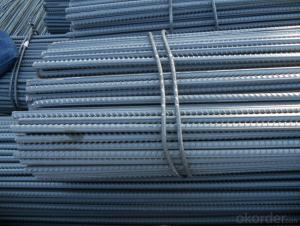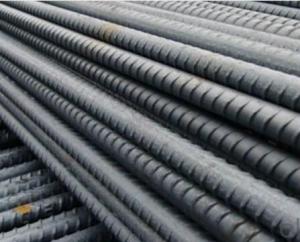Hot Rolled Steel Deformed Steel Bar/D-BAR HRB500/B500B/GR60
- Loading Port:
- Tianjin
- Payment Terms:
- TT OR LC
- Min Order Qty:
- 200 m.t.
- Supply Capability:
- 40000 m.t./month
OKorder Service Pledge
OKorder Financial Service
You Might Also Like
Specification
Product Description:
OKorder is offering Hot Rolled Steel Deformed Steel Bar/D-BAR HRB500/B500B/GR60 at great prices with worldwide shipping. Our supplier is a world-class manufacturer of steel, with our products utilized the world over. OKorder annually supplies products to European, North American and Asian markets. We provide quotations within 24 hours of receiving an inquiry and guarantee competitive prices.
Product Applications:
Hot Rolled Steel Deformed Steel Bar/D-BAR HRB500/B500B/GR60 are ideal for structural applications and are widely used in the construction of buildings and bridges, and the manufacturing, petrochemical, and transportation industries.
Product Advantages:
OKorder's Hot Rolled Steel Deformed Steel Bar/D-BAR HRB500/B500B/GR60 are durable, strong, and resist corrosion.
Main Product Features:
· Premium quality
· Prompt delivery & seaworthy packing (30 days after receiving deposit)
· Corrosion resistance
· Can be recycled and reused
· Mill test certification
· Professional Service
· Competitive pricing
Product Specifications:
Diameter(mm) | Section area (mm²) | Mass(kg/m) | Weight of 12m bar(kg) |
6 | 28.27 | 0.222 | 2.664 |
8 | 50.27 | 0.395 | 4.74 |
10 | 78.54 | 0.617 | 7.404 |
12 | 113.1 | 0.888 | 10.656 |
14 | 153.9 | 1.21 | 14.52 |
16 | 201.1 | 1.58 | 18.96 |
18 | 254.5 | 2.00 | 24 |
20 | 314.2 | 2.47 | 29.64 |
22 | 380.1 | 2.98 | 35.76 |
25 | 490.9 | 3.85 | 46.2 |
28 | 615.8 | 4.83 | 57.96 |
32 | 804.2 | 6.31 | 75.72 |
36 | 1018 | 7.99 | 98.88 |
40 | 1257 | 9.87 | 118.44 |
50 | 1964 | 15.42 | 185.04 |
Packaging & Delivery of HRB400 Deformed Steel Bar:
Packaging Detail: products are packed in bundle and then shipped by container or bulk vessel, deformed bar is usually naked strapping delivery, when storing, please pay attention to moisture proof. The performance of rust will produce adverse effect.
Each bundle weight: 2-3MT, or as required
Payment term: TT or L/C
Delivery Detail: within 45 days after received advanced payment or LC.
Label: to be specified by customer, generally, each bundle has 1-2 labels
Trade terms: FOB, CFR, CIF
FAQ:
Q1: Why buy Materials & Equipment from OKorder.com?
A1: All products offered byOKorder.com are carefully selected from China's most reliable manufacturing enterprises. Through its ISO certifications, OKorder.com adheres to the highest standards and a commitment to supply chain safety and customer satisfaction.
Q2: How do we guarantee the quality of our products?
A2: We have established an advanced quality management system which conducts strict quality tests at every step, from raw materials to the final product. At the same time, we provide extensive follow-up service assurances as required.
Q3: How soon can we receive the product after purchase?
A3: Within three days of placing an order, we will begin production. The specific shipping date is dependent upon international and government factors, but is typically 7 to 10 workdays.
Q4: What makes stainless steel stainless?
A4: Stainless steel must contain at least 10.5 % chromium. It is this element that reacts with the oxygen in the air to form a complex chrome-oxide surface layer that is invisible but strong enough to prevent further oxygen from "staining" (rusting) the surface. Higher levels of chromium and the addition of other alloying elements such as nickel and molybdenum enhance this surface layer and improve the corrosion resistance of the stainless material.
Q5: Can stainless steel rust?
A5: Stainless does not "rust" as you think of regular steel rusting with a red oxide on the surface that flakes off. If you see red rust it is probably due to some iron particles that have contaminated the surface of the stainless steel and it is these iron particles that are rusting. Look at the source of the rusting and see if you can remove it from the surface.
Images:
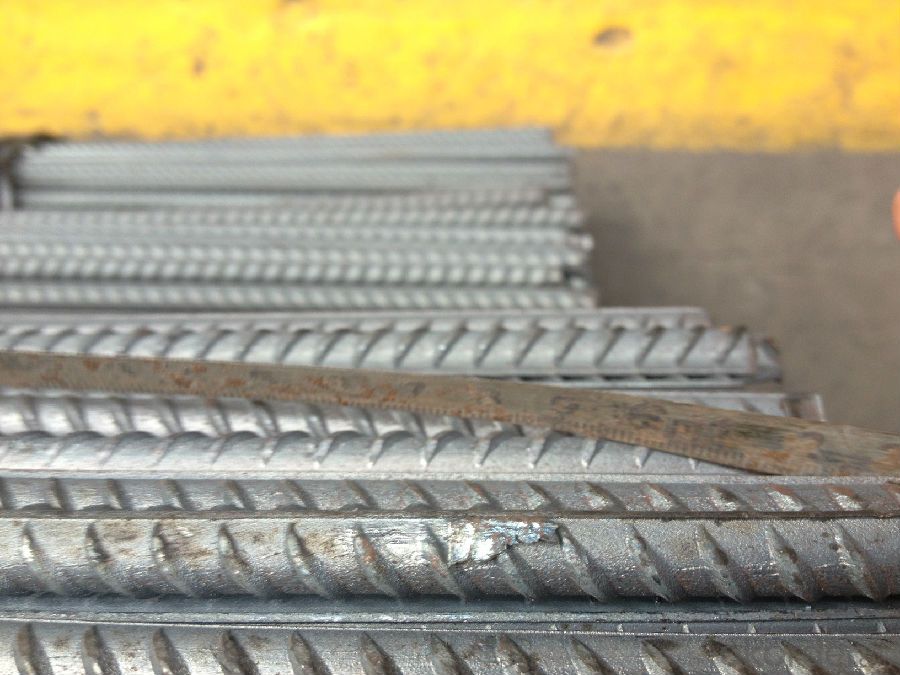
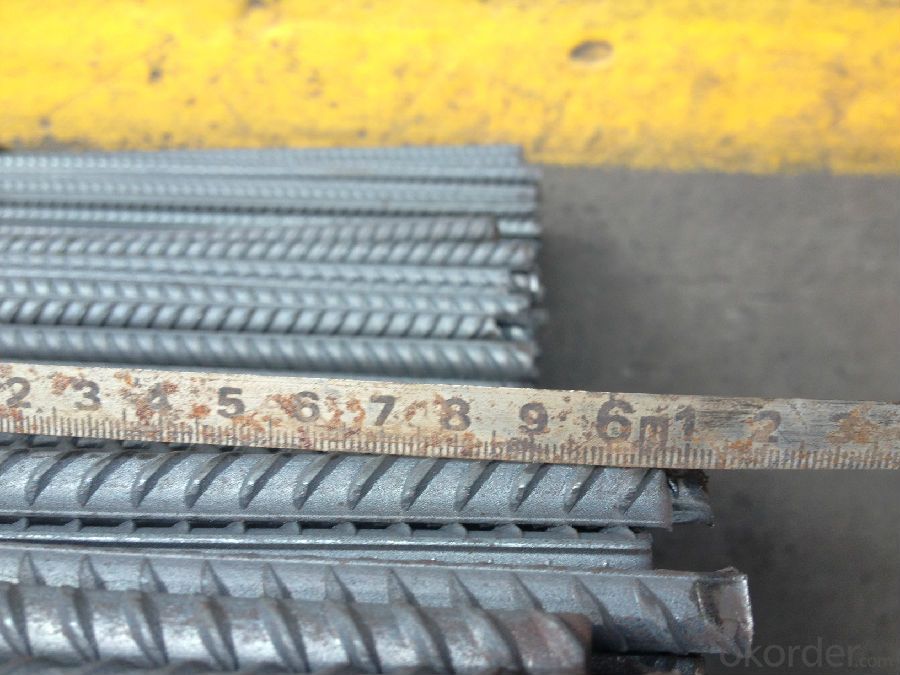
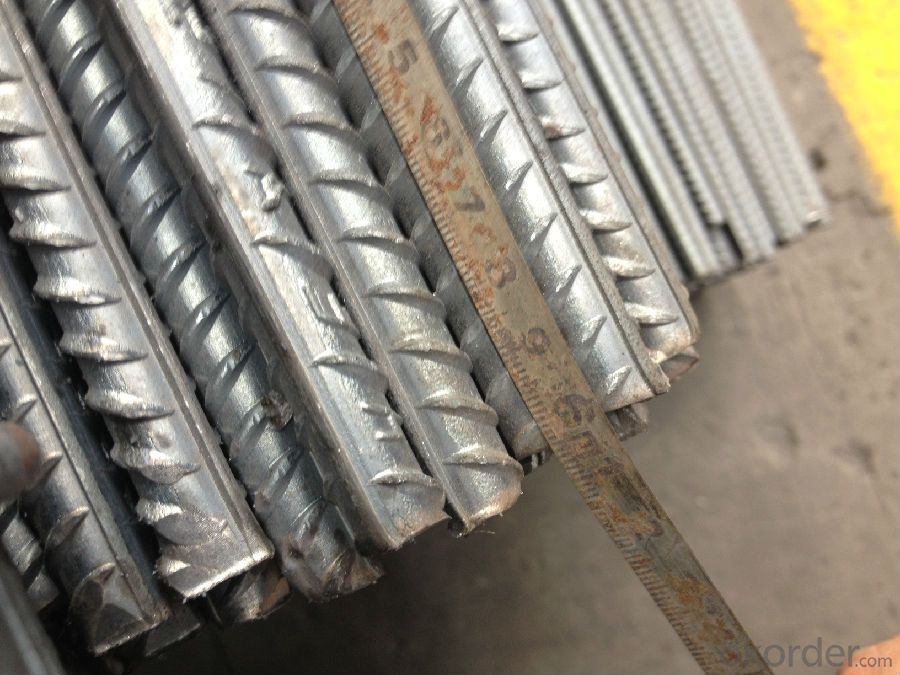
- Q: Can steel rebars be used in modular bridge construction?
- Yes, steel rebars can be used in modular bridge construction. Steel rebars provide strength, durability, and structural stability to the bridge modules, making them an ideal choice for this type of construction.
- Q: Can steel rebars be used in blast-resistant building construction?
- Yes, steel rebars can be used in blast-resistant building construction. Steel rebars are commonly used as reinforcement in concrete structures, including blast-resistant buildings. The high tensile strength and durability of steel make it a suitable material for withstanding the impact of explosions, enhancing the structural integrity and safety of the building.
- Q: Can steel rebars be used in the construction of hospitals and healthcare facilities?
- Yes, steel rebars can be used in the construction of hospitals and healthcare facilities. Steel rebars provide structural integrity and strength to the buildings, ensuring their safety and durability. Additionally, steel rebars are resistant to fire, moisture, and corrosion, making them suitable for healthcare facilities that require high standards of cleanliness and hygiene.
- Q: How long do steel rebars typically last before corroding?
- Steel rebars typically last for several decades before they start to corrode, depending on various factors such as the quality of the steel, environmental conditions, and the presence of protective coatings.
- Q: Are there any limitations on the length of steel rebars?
- Industry standards and guidelines typically dictate the length of steel rebars, imposing limitations based on practical and logistical factors. One restriction pertains to the transportation and handling of rebars. Although steel rebars are usually produced in lengthy sizes, such as up to 60 feet (18 meters) or more, the weight and rigidity of rebars make it challenging to transport and maneuver them effectively. Therefore, rebars are commonly cut into shorter lengths for easier transportation and handling on construction sites. Another limitation concerns the structural integrity of rebars. Lengthier rebars are more susceptible to bending, warping, or sagging, which can compromise their effectiveness in reinforcing concrete structures. To ensure structural integrity, rebars are often restricted to specific lengths based on the particular application and design requirements. Furthermore, local building codes and regulations may impose additional limitations. These regulations aim to guarantee the safety and durability of structures. They might stipulate the maximum length of steel rebars permissible for different construction applications to meet the required standards and ensure the building's structural integrity. In conclusion, while steel rebars can be manufactured in extended lengths, considerations such as practicality, structural integrity, and compliance with local regulations often impose limitations on their size. These limitations are in place to facilitate the efficient transportation and handling of rebars, maintain their structural integrity, and adhere to building codes and regulations.
- Q: How do steel rebars contribute to the fire resistance of a building?
- Steel rebars contribute to the fire resistance of a building by providing structural support and enhancing the overall stability of the structure. In the event of a fire, the steel rebars help maintain the structural integrity of the building, preventing collapse and allowing occupants more time to evacuate safely. Additionally, steel has a high melting point and low thermal conductivity, which slows down the spread of fire and heat through the building, providing firefighters with more time to control the situation.
- Q: Can steel rebars be used in structures with high resistance to fatigue?
- Structures with high resistance to fatigue can utilize steel rebars. These rebars are commonly employed as reinforcement in concrete structures due to their durability and high tensile strength. They enhance the strength and support of the concrete, making it more resilient against various loads and stresses, including fatigue. Fatigue occurs when a material weakens due to repeated stress cycles, potentially causing structural failure over time. Steel rebars, particularly those made from high-strength steel, are specifically designed to withstand cyclic loading and offer exceptional resistance to fatigue. With their high fatigue strength, they can endure multiple stress cycles without significant deterioration. In structures with high fatigue resistance, engineers strategically position steel rebars to distribute and dissipate applied loads. This reduces stress concentrations and minimizes the risk of fatigue failure. The reinforcement provided by steel rebars improves the overall structural integrity and longevity of the construction. Furthermore, the use of steel rebars allows for the implementation of various design techniques, including the inclusion of additional reinforcing elements like stirrups and tie hooks. These elements further enhance the structure's resistance to fatigue. By considering these design considerations, steel rebars effectively mitigate the effects of cyclic loading and maintain the structure's stability and performance over time. However, it is important to note that the fatigue resistance of a structure does not solely rely on steel rebars. Other factors, such as the quality of concrete, proper detailing and placement of rebars, and adherence to proper construction practices, also impact the overall fatigue performance. Therefore, it is crucial to adopt a comprehensive approach that incorporates appropriate design, material selection, and construction techniques to achieve structures with high resistance to fatigue.
- Q: Can steel rebars be used in structures with heavy snow loads?
- Indeed, structures burdened with heavy snow loads can incorporate steel rebars. These rebars are commonly employed in construction to fortify concrete structures and augment their strength. When designing structures in regions prone to heavy snowfall, engineers carefully consider the weight of the snow and ensure that the structure is equipped to bear the additional load. Steel rebars possess the strength necessary to endure substantial loads, allowing them to reinforce the concrete within a structure and enhance its resistance against snow-induced forces. Furthermore, steel rebars aid in distributing the load evenly throughout the structure, mitigating the risk of failure or collapse. Nevertheless, it is crucial to seek guidance from a structural engineer or a knowledgeable professional familiar with local building codes and regulations to guarantee the proper design and construction of the structure to meet the specific requirements for snow loads in the area.
- Q: Can steel rebars be used in structures with high sulfate content in soil or water?
- In structures that contain high sulfate levels in soil or water, it is not recommended to use steel rebars. The reaction between sulfates and steel, specifically the iron within the steel rebars, can result in corrosion and the weakening of the structure. This phenomenon, commonly referred to as sulfide attack or sulfate attack, has the potential to lead to the deterioration of the rebars and ultimately compromise the overall integrity of the structure. As a result, it is advisable to explore alternative materials such as stainless steel rebars or non-metallic reinforcement options like fiber-reinforced polymers (FRP) in order to ensure the longevity and safety of the structure.
- Q: What is the minimum yield strength of steel rebars?
- The minimum yield strength of steel rebars typically varies depending on the type and grade of steel being used. However, in general, the minimum yield strength of steel rebars is commonly around 400 megapascals (MPa) or 58,000 pounds per square inch (psi).
Send your message to us
Hot Rolled Steel Deformed Steel Bar/D-BAR HRB500/B500B/GR60
- Loading Port:
- Tianjin
- Payment Terms:
- TT OR LC
- Min Order Qty:
- 200 m.t.
- Supply Capability:
- 40000 m.t./month
OKorder Service Pledge
OKorder Financial Service
Similar products
Hot products
Hot Searches
Related keywords
